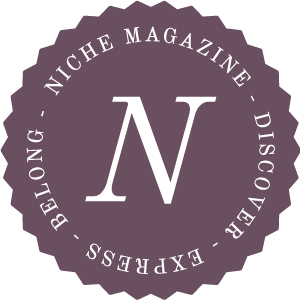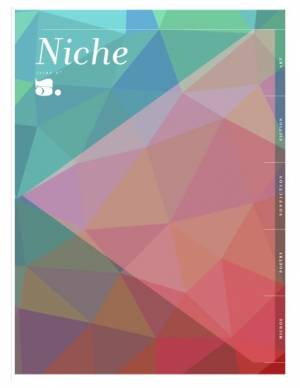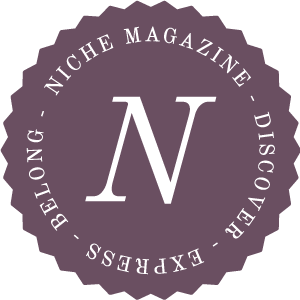In Fall 2011, U of I English and creative writing students launched the online literary magazine, Niche Magazine. Although these students have graduated, they still carry out their skills and passions through the publication, which is released annually. To encourage limitless expression, Niche is currently accepting submissions for all types of work: experimental or conventional, literary or genre fiction, creative or standard nonfiction, poetry, short stories, interviews, artwork, and graphic media. Submissions are encouraged from all community members, not just people associated with the University of Illinois, from September 1st through December 31st, 2015.
 Managing and Founding Editor Katya Cummins had the idea as a freshman at the University of Iowa. Her dorm fortunately fostered the Iowa Writers Living Learning Community (IWLLC), where she met Fiction Editor Rochelle Liu and Art Coordinator and Acquisitions Editor Shannon Hewson. She expressed to them her interest in starting a “literary magazine that looked beyond aesthetics and genres,” as Cummins says. The two not only encouraged her to do so, but they also agreed to be on the staff when the time came.
Managing and Founding Editor Katya Cummins had the idea as a freshman at the University of Iowa. Her dorm fortunately fostered the Iowa Writers Living Learning Community (IWLLC), where she met Fiction Editor Rochelle Liu and Art Coordinator and Acquisitions Editor Shannon Hewson. She expressed to them her interest in starting a “literary magazine that looked beyond aesthetics and genres,” as Cummins says. The two not only encouraged her to do so, but they also agreed to be on the staff when the time came.
Cummins then transferred to Illinois where she met Mary Keutelian, media coordinator and fiction reader, and Katie Cantwell, poetry editor, in her undergraduate creative writing classes. And that’s where Niche’s story really begins…
When Cummins began seeking publication, she ran into two main types of literary magazines: those that published “stories that were clever at the sentence level, but held no emotional resonance,” as Cummins describes them, and those that only published straight realism.
Dissatisfied with publications’ requirements and emphasis, Cummins and friends got organized, made a website, activated their social networks, and purchased a Submission Manager, using NewPages and The Review Review to advertise for Niche. The response was overwhelming.
As for the important finishing touches — the magazine design — Cummins counts herself lucky. Someone from buzz magazine passed along former Illinois student Maria Surawska’s information. After an initial query, Surawska submitted a template that Cummins found to be both beautiful and elegant. “The rest,” as Cummins says, “is history.”
Smile Politely caught up with Katya for some more details and insights on the submissions, for those who might be seeking publication, or would just love to read quality local authors.
SP: Niche includes a wide variety of work, which I think is awesome; however, are there certain requirements applicants must meet in order to be published in Niche No. 6?
 Katya Cummins: Write us a good story or poem or micro or a cross between all three. We don’t care what aesthetic or what genre submitters are writing in. If the story holds interest for the writer, then it will most likely hold interest for the reader.
Katya Cummins: Write us a good story or poem or micro or a cross between all three. We don’t care what aesthetic or what genre submitters are writing in. If the story holds interest for the writer, then it will most likely hold interest for the reader.
The biggest mistake that writers make, and I’ve been guilty of this myself, is submitting work too soon. That is, we’ve read a lot of submissions that are still in the drafting stages. The authors haven’t figured out what their pieces are about.
The other thing we see a lot of are submissions that lack polish, which becomes evident when the pieces lack or lose musicality. By musicality, I mean that all elements–motifs, symbols, sentence structures, length, POV [point of view], and so on–should come together in a cohesive way to create significant human moments. With that being said, writers and artists should not be afraid to submit to us. We’re here to support emerging writers in any way we can. We will be accepting submissions again in September!
SP: Do you seem to receive one genre more than others? Do submissions come from the same age group?
Cummins: We’ve branded ourselves as a “literary” magazine, and so we tend to receive a lot of submissions that are firmly rooted in the “literary” tradition. I do want to point out, however, that a story can still have literary elements but be categorized as genre (noir, science-fiction, and fantasy). In our first issue, we republished an interview with Neil Gaiman (interviewed by Scott Baseler) that discusses the intersections between literary fiction and genre fiction. Neil Gaiman is often described as a science fiction and fantasy writer, but the way he talks and writes is very literary. In our most recent issue, we published a micro by Christine Kendall, called “Finishing Up,” which I liked because it defied how micros are currently being written. Right now, you see a lot of micros that might as well be poems. But Kendall’s piece showed how micros could be narrative in nature and still be just as complex and engaging as micros written in the Imagist tradition.
The age group and backgrounds of our submitters and published authors vary widely. We’ve published a lot of writers who were trained in MFA Programs. These submitters tend to range between the ages of 20-35. They’re the ones who are actively and very deliberately building careers as writers. Then we’ve published those artists who have been passionate about the craft all their lives, but who have only had time to write as a hobby. These authors tend to be older, around the ages of 40-60. I find they’re the ones with the more interesting bios. They’ve lived a lot of life, and the richness of their experiences is very evident in their work. I think the backgrounds and ages of our submitters vary because we’ve devoted ourselves to helping emerging writers rather than building a power-base by publishing very accomplished authors (though we have published quite a number of seasoned authors as well).
SP: What is your favorite part about being involved with Niche?
Cummins: My favorite part is reading submissions. There are so many talented writers and artists out there. It is a pretty humbling experience. I also love providing in-depth feedback. If a submitter asks, I will critique their work for free. So few literary magazines offer explanations. (It’s understandable. Providing feedback is time consuming). I found that a lot of submitters are so grateful for feedback that they are more than willing to pay me for my time. That’s how I began my professional but affordable critiquing service. I think that a lot of literary magazines are offering a critiquing service of some sort these days, but I think we’re still the most affordable service out there.
I also like seeing the authors we’ve published succeed. A lot of them, such as Sean Jackson, Lou Gaglia, and Rosebud Ben-Oni have gone on to publish their first books or chapbooks. We’ve also published writers who have gone on to win literary awards. For instance, Ronit Feinglass Plank, an author from our second issue, won the Eric Hoffer Prose Award in Best Writing this year. It’s just nice to have played some small part in their careers. We wish all our contributors well.
SP: What has been the most surprising thing (to you) that has happened to Niche since its start in 2011?
Cummins: The most surprising thing is that Niche is still alive and kicking. Literary magazines tend to be financial drains. Very few make money, and for this reason, it is not uncommon for a lot of new literary magazines to go under after their first or second issue, and therefore, there is no real shame if a magazine folds. I was sure we wouldn’t survive past our first issue, but we have. I will say our success is mainly due to the fact that I have very dedicated editors and an awesome designer. They’re simply the best.
I remember talking to an editor of a very successful literary magazine at the last AWP, the big conference for writers, and saying, “I run this small literary magazine. It’s called Niche,” and she suddenly lit up, and genuinely said: “I know of that magazine! It’s such a beautiful magazine! You guys do a great job!” I remember feeling pleased but surprised that someone outside those we’ve published knew anything about us.
SP: What’s the logic behind making Niche an annual vs. a weekly, monthly, etc.?
Cummins: The simplest and most truthful explanation is money. We only have enough money to produce one very good issue a year. The other reason is time. It takes time to read, design, proofread, promote, and expand our audience. We’re a non-profit and an all-volunteer organization. We all have lives and other jobs that unfortunately demand our attention. My hope for the future is to have enough money saved to re-design our site so we can begin publishing online issues called “Niche Monthly,” which would contain a Letter from the Editor, one fiction piece, one nonfiction piece, one poem, one MFA Spotlight, one Literary Journal Spotlight, and one book review. But again, I want the website to be elegant and professional. Of course, if this happens, we’ll release a fully designed Niche Magazine on an annual cycle like we’ve been doing for the past four years.
SP: What about Niche would appeal to readers of Smile Politely?
Cummins: We’re a fun, interesting, and beautiful read. We’re also dedicated to our writers and readers. We interview all our contributors and run reviews of their first books. Our website is dedicated to offering resources for students who want to continue onto MFA Programs, or who have graduated from MFA Programs, and are now seeking careers outside academia. Most importantly, we’re open to anything. E-mail us with an idea for an article or interview or review or anything else. We don’t promise publication, but we do promise to consider all proposals with an open mind. We’re a safe place for people to express and belong. Truly.
Cummins also said that even though Niche is currently taking submissions for Niche No. 6, the publication takes year-round submissions for Niche Features, which appear on its website. “Anyone who is interested in submitting material can visit our Submission Manager or the submission guidelines on our website,” she said.
Niche is not unlike SP — both publications are staffed by artists who have a true passion for what they do. You can count on quality pieces from Niche because the editors and designers make time for the publication outside of their other jobs and responsibilities and there is a heavy, accepting focus on the artistic and writing community.
Pictures provided by Katya Cummins.








